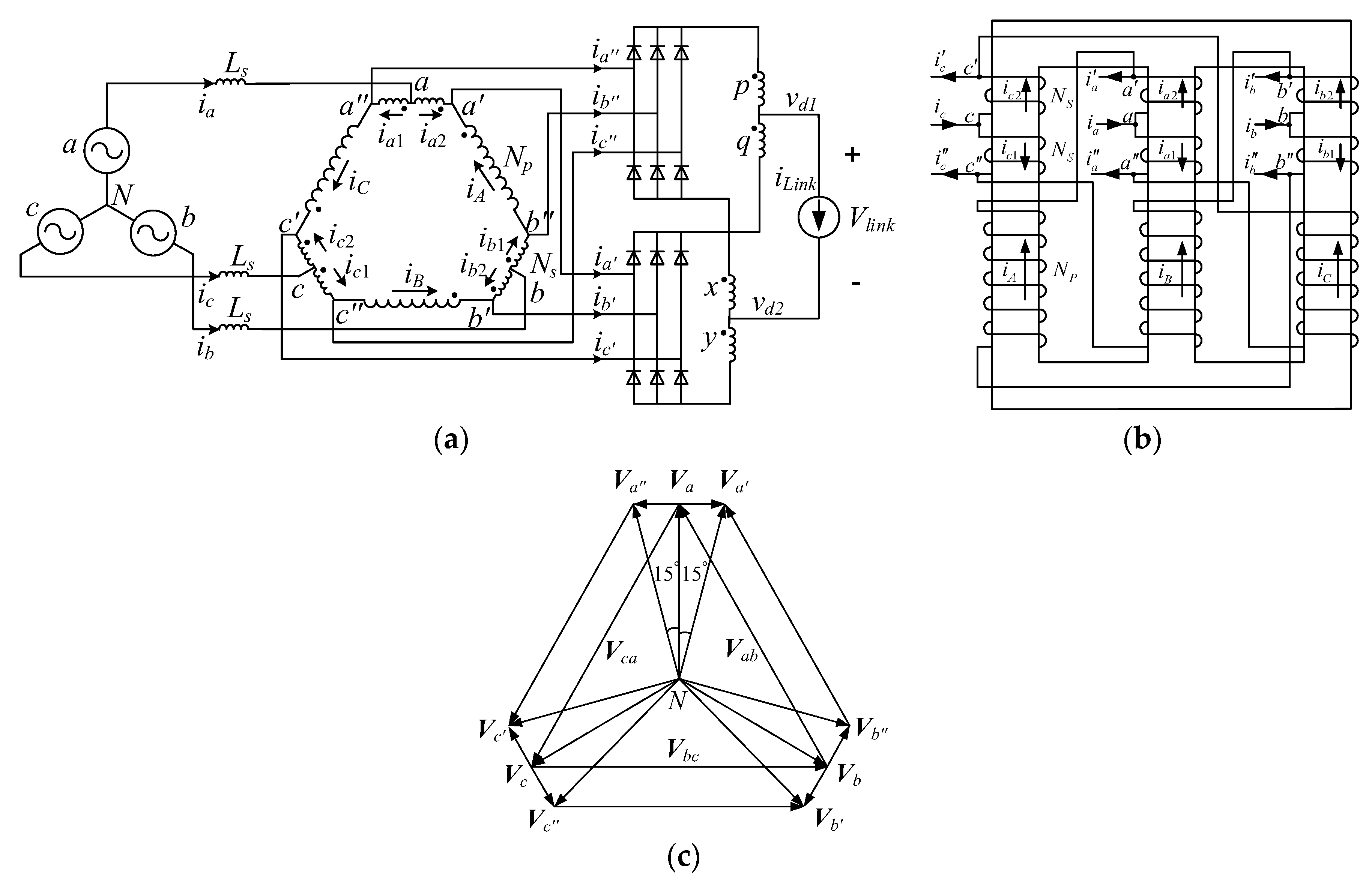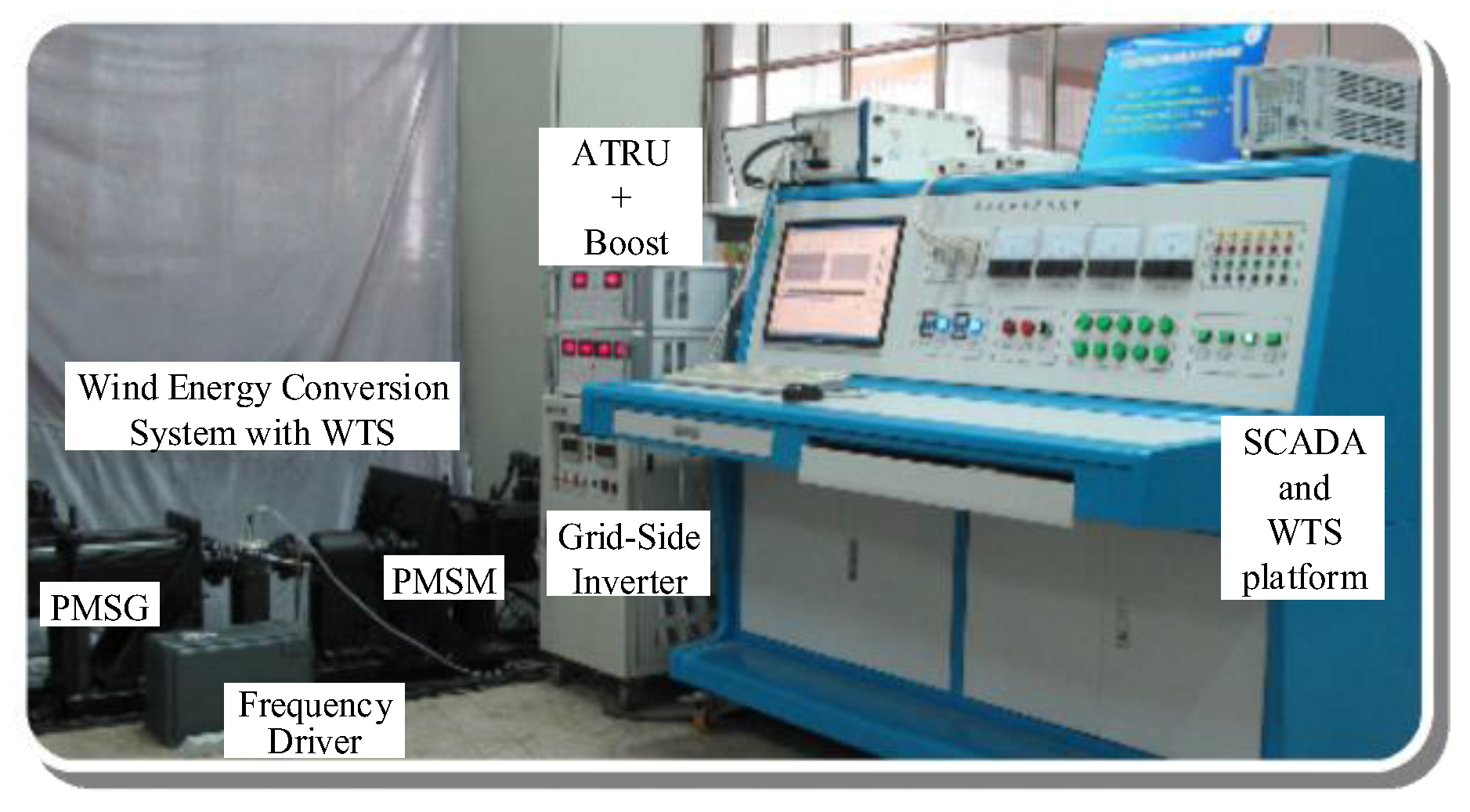On Reducing the Shaft Torque Ripple of Small-to-Medium-Scale Wind Energy Conversion Systems Using Multi-Pulse Autotransformer Rectifier
Abstract
:1. Introduction
2. Design of the 12-Pulse ATRU in WECS
2.1. Structure of the Proposed ATRU
2.2. Characteristics of the Output Voltage
2.3. THD Analysis of the Input Current
2.4. Designing of the Autotransformer in WECS Application
3. Overall Power Control Strategy
3.1. MPPT Operation Mode
3.2. CS Operation Mode
3.3. CP Operation Mode
4. Experimental Study
5. Conclusions
Acknowledgments
Author Contributions
Conflicts of Interest
Nomenclature
| v, vcut-in, vcut-out | wind speed, cut-in wind speed, and cut-out wind speed |
| vΩN, vN | wind speed and rated rotor speed, rated wind speed |
| Cp(λ, β), Cpmax | power coefficient of the wind turbine and its maximum value |
| λ, λopt | tip-speed-ratio and its optimum value |
| β | pitch angle |
| ω, ΩN | generator speed and its rated value |
| ωcut-out | generator speed at cut-out wind speed |
| Pr, PrN | aerodynamic power and its rated value |
| R | radius of the swept area of the turbine |
| ρ | air density |
| kopt | optimum coefficient |
| J | total Inertia of the WECS |
| Vlink, Vlinkopt, Vlinkmax | dc-link voltage, its optimum value and its maximum value |
| ilink, i*link | dc-link current and its reference value |
| p | number of pole-pairs |
| RsG | resistance of the generator stator winding |
| LsG | inductance of the generator stator winding |
| kω | voltage estimation coefficient |
| Φ | flux |
| ke | potential constant |
| E | electromotive force |
| kω | voltage estimation coefficient |
| Np, Ns | number of turns of the long and short windings |
| Lp | inductance of the balancing reactor |
| Ls | leakage inductance of the ATRU |
| L | input inductance of the boost converter |
| Clink, Cdc | dc-link and dc-bus capacitors |
| vd1, vd2, vpn, vqn, vxn, vyn | defined voltages on the balancing reactors |
| Vin, Vs | rms voltages across the primary and secondary windings |
| VNp, VNs | rms voltages on the long and short windings of each limb |
| Vn, Vn′, Vn″ | phase voltages and their shifted values, n takes a, b, c |
| in, in′, in″ | phase currents and their shifted values, n takes a, b, c |
| iA, iB, iC | currents in the long windings |
| ia1,2, ib1,2, ic1,2 | currents in the short windings |
| kA | loop gain of the current control loop |
| η | system efficiency |
| Iaf | rms value of the fundamental current |
| Patr | magnetic power rating of the autotransformer |
Appendix A
| Parameters | Value |
|---|---|
| Turbine | |
| Radius of the swept area R (m) | 0.95 |
| Numbers of blades | 3 |
| Total Inertia of the WECS J (kg·m2) | 0.42 |
| Rated power PrN (kW) | 1.2 |
| Cut-in/rated rotor speed corresponding/rated/cut-out wind speed (m/s) | 6/12/14/25 |
| Maximum power coefficient Cpmax and λopt | 0.277/4.1 |
| PMSG/PMSM and electrical subsystem | |
| Rated rotor speed ΩN (RPM) | 500 |
| Number of pole-pares p | 4 |
| Rated power (kW) | 2 |
| Resistance of stator windings RsG (Ω) | 0.42 |
| Inductance of stator windings LsG (mH) | 3.6 |
| Flux (Wb) | 0.435 |
| Voltage estimation coefficient kω | 0.3 |
| Maximum dc-link voltage Vlinkmax (V) | 150 |
| Leakage inductance of the ATRU Ls (μH) | 2 |
| Number of turns of the long and short windings Np/Ns | 285/52 |
| Inductance of the balancing reactor Lp (mH) | 10 |
| Input inductance of the boost converter L (μH) | 200 |
| dc-link and dc-bus capacitors Clink/Cdc (μF) | 10/1000 |
| dc-Bus voltage nominal value Vdc (V) | 180 |
| Control System | |
| Gains of regulator PID Kp/Ki/Kd | 0.002/0.02/0.1 |
| Gains of regulator PI1 Kp1/Ki1 | 10/7 |
| Gains of regulator PI2 Kp2/Ki2 | 10/50 |
References
- U.S. Department of Energy (DOE). 2014 Distributed Wind Market Report. Available online: http://www.energy.gov/ (accessed on 1 August 2015).
- British Wind Energy Association (BWEA). Small and Medium Wind U.K. Market Report (2015). Available online: http://www.RenewableUK.com (accessed on 28 December 2015).
- Wei, C.; Zhang, Z.; Qiao, W.; Qu, L. An adaptive network-based reinforcement learning method for MPPT control of PMSG wind energy conversion systems. IEEE Trans. Power Electron. 2016, 31, 7837–7848. [Google Scholar] [CrossRef]
- Chen, J.; Lin, T.; Wen, C.; Song, Y.D. Design of a unified power controller for variable speed fixed-pitch wind energy conversion system. IEEE Trans. Ind. Electron. 2016, 63, 4899–4908. [Google Scholar] [CrossRef]
- Chen, Z.; Guerrero, J.M.; Blaabjerg, F. A review of the state of the art of power electronics for wind turbines. IEEE Trans. Power Electron. 2009, 24, 1859–1874. [Google Scholar] [CrossRef]
- Saleh, S.A.; Aljankaway, A.S.; Abu-Khaizaran, M.S.; Alsayid, B. Influences of power electronic converters on voltage-current behaviors during faults in DGUs-part I: Wind energy conversion systems. IEEE Trans. Ind. Appl. 2015, 51, 2819–2831. [Google Scholar] [CrossRef]
- Nguyen, H.T.; Lee, D.C. Advanced fault ride-through technique for PMSG wind turbine systems using line-side converter as STACOM. IEEE Trans. Ind. Electron. 2013, 60, 2842–2850. [Google Scholar] [CrossRef]
- Ribrant, J.; Bertling, L.M. Survey of failures in wind power systems with focus on Swedish wind power plants during 1997–2005. IEEE Trans. Energy Convers. 2007, 22, 167–173. [Google Scholar] [CrossRef]
- Sunan, E.; Kucuk, F.; Goto, H.; Guo, H.J. Three-phase full-bridge converter controlled permanent magnet reluctance generator for small-scale wind energy conversion systems. IEEE Trans. Energy Convers. 2014, 29, 1–9. [Google Scholar] [CrossRef]
- Zhang, Z.; Zhao, Y.; Qiao, W.; Qu, L. A discrete-time direct torque control for direct-drive PMSG-based wind energy conversion systems. IEEE Trans. Ind. Appl. 2015, 51, 3504–3514. [Google Scholar] [CrossRef]
- Mirecki, A.; Roboam, X.; Richardeau, F. Architecture complexity and energy efficiency of small wind turbines. IEEE Trans. Ind. Electron. 2007, 54, 660–670. [Google Scholar] [CrossRef]
- Park, Y.S.; Koo, M.M.; Jang, S.M.; Choi, J.Y.; You, D.J. Performance evaluation of radial- and axial-flux PM wind power generators with mechanical energy storage system. IEEE Trans. Energy Convers. 2015, 30, 237–245. [Google Scholar] [CrossRef]
- Chen, J.; Chen, J.; Gong, C. New overall power control strategy for variable-speed fixed-pitch wind turbines within the whole wind velocity range. IEEE Trans. Ind. Electron. 2013, 60, 2652–2660. [Google Scholar] [CrossRef]
- Dalala, Z.M.; Zahid, Z.U.; Lai, J.S. New overall control strategy for small-scale WECS in MPPT and stall regions with mode transfer control. IEEE Trans. Energy Convers. 2013, 28, 1082–1092. [Google Scholar] [CrossRef]
- Gong, G.; Heldwein, M.L.; Drofenik, U.; Minibock, J.; Mino, K.; Kolar, J.W. Comparative evaluation of three-phase high-power-factor AC–DC converter concepts for application in future more electric aircraft. IEEE Trans. Ind. Electron. 2005, 52, 727–737. [Google Scholar] [CrossRef]
- Yang, T.; Bozhko, S.; Asher, G. Functional modelling of symmetrical multipulse autotransformer rectifier units for aerospace applications. IEEE Trans. Power Electron. 2015, 30, 4704–4713. [Google Scholar] [CrossRef]
- Uan-Zo-li, A.; Burgos, R.; Wang, F.; Boroyevich, D.; Lacaux, F.; Tardy, A. Comparison of prospective topologies for aircraft autotransformer rectifier units. In Proceedings of the 29th Annual Conference IEEE Indusrial Electronics Society, Roanoke, VA, USA, 2–6 November 2003; pp. 1122–1127. [Google Scholar]
- Rendusara, D.A.; Jouanne, A.V.; Enjeti, P.N.; Paice, D.A. Design considerations for 12-pulse diode rectifier systems operating under voltage unbalance and pre-existing voltage distortion with some corrective measures. IEEE Trans. Ind. Appl. 1996, 32, 1293–1303. [Google Scholar] [CrossRef]
- Choi, S.; Enjeti, P.N.; Lee, H.H.; Pitel, I.J. A new active interphase reactor for 12-pulse rectifiers provides clean power utility interface. IEEE Trans. Ind. Appl. 1996, 32, 1304–1311. [Google Scholar] [CrossRef]
- Kalpana, R.; Bhuvaneswari, G.; Singh, B.; Singh, S. Harmonic mitigator based on 12-pulse as-dc converter for switched mode power supply. IET Power Electron. 2010, 3, 947–964. [Google Scholar] [CrossRef]
- Choi, S.; Prasad, N.E.; Pitel, I.J. Polyphase transformer arrangments with reduced kVA capacities for harmonic current reduction in rectifier-type utility interface. IEEE Trans. Power Electron. 1996, 11, 680–690. [Google Scholar] [CrossRef]
- Singh, B.; Gairola, S.; Singh, B.N.; Chandra, A.; Al-Haddad, K. Multipulse AC-DC converters for improving power quality: A review. IEEE Trans. Power Electron. 2009, 23, 260–281. [Google Scholar] [CrossRef]
- Paice, D.A. Multipulse Converter System. U.S. Patent 4,876,634, 24 October 1989. [Google Scholar]
- Reis, M.M.; Soares, B.; Barreto, L.H.S.C.; Freitas, E.; Silva, C.E.A.; Bascope, R.T.; Oliveira, D.S. A variable speed wind energy conversion system connected to the grid for small wind generator. In Proceedings of the 23th Annual IEEE Applied Power Electronics Conference and Exposition, Austin, TX, USA, 24–28 February 2008; pp. 751–755. [Google Scholar]
- Pan, C.T.; Juan, Y.L. A novel sensorless MPPT controller for a high-efficiency microscale wind power generation system. IEEE Trans. Energy Convers. 2010, 25, 207–216. [Google Scholar]
- Singh, B.; Sharma, S. Design and implementation of four-leg voltage-source-converter-based VFC for autonomous wind energy conversion system. IEEE Trans. Ind. Electron. 2012, 59, 4694–4703. [Google Scholar] [CrossRef]
- Bianchi, F.D.; de Battista, H.; Mantz, R.J. Wind Turbine Control Systems: Principles, Modeling and Gain Scheduling Design; Springer: London, UK, 2007. [Google Scholar]
- William, C.; McLyman, T. Transformer and Inductor Design Handbook, 3rd ed.; Marcel Dekker Press: New York, NY, USA, 2004. [Google Scholar]
- Xia, Y.Y.; Fletcher, J.E.; Finney, S.J.; Ahmed, K.H.; Williams, B.W. Torque ripple analysis and reduction for wind energy conversion systems using uncontrolled rectifier and boost converter. IET Renew. Power Gener. 2011, 5, 377–386. [Google Scholar] [CrossRef]
- Chen, J.; Chen, J.; Gong, C. Design and analysis of dynamic wind turbine simulator for wind energy conversion system. In Proceedings of the 38th Annual Conference on IEEE Industrial Electronics Society, Montreal, QC, Canada, 25–28 October 2012; pp. 971–977. [Google Scholar]
- Chen, J.; Chen, J.; Gong, C. On optimizing the transient load of variable-speed wind energy conversion system during the MPP tracking process. IEEE Trans. Ind. Electron. 2014, 61, 4698–4706. [Google Scholar] [CrossRef]
- Hoffmann, D.R. A Comparison of Control Concepts for Wind Turbines in Terms of Energy Capture. Ph.D. Dissertation, Darmstadt University of Technology, Darmstadt, Germany, 2002. [Google Scholar]
- Chen, J.; Chen, J.; Gong, C. On optimizing the aerodynamic load acting on the turbine shaft of PMSG-based direct-drive wind energy conversion system. IEEE Trans. Ind. Electron. 2014, 61, 4022–4031. [Google Scholar] [CrossRef]











© 2018 by the authors. Licensee MDPI, Basel, Switzerland. This article is an open access article distributed under the terms and conditions of the Creative Commons Attribution (CC BY) license (http://creativecommons.org/licenses/by/4.0/).
Share and Cite
Chen, J.; Chen, J. On Reducing the Shaft Torque Ripple of Small-to-Medium-Scale Wind Energy Conversion Systems Using Multi-Pulse Autotransformer Rectifier. Energies 2018, 11, 379. https://doi.org/10.3390/en11020379
Chen J, Chen J. On Reducing the Shaft Torque Ripple of Small-to-Medium-Scale Wind Energy Conversion Systems Using Multi-Pulse Autotransformer Rectifier. Energies. 2018; 11(2):379. https://doi.org/10.3390/en11020379
Chicago/Turabian StyleChen, Jie, and Jiawei Chen. 2018. "On Reducing the Shaft Torque Ripple of Small-to-Medium-Scale Wind Energy Conversion Systems Using Multi-Pulse Autotransformer Rectifier" Energies 11, no. 2: 379. https://doi.org/10.3390/en11020379





